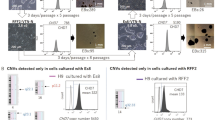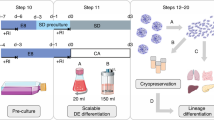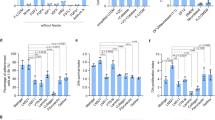Abstract
This protocol describes an EDTA-based passaging procedure to be used with chemically defined E8 medium that serves as a tool for basic and translational research into human pluripotent stem cells (PSCs). In this protocol, passaging one six-well or 10-cm plate of cells takes about 6–7 min. This enzyme-free protocol achieves maximum cell survival without enzyme neutralization, centrifugation or drug treatment. It also allows for higher throughput, requires minimal material and limits contamination. Here we describe how to produce a consistent E8 medium for routine maintenance and reprogramming and how to incorporate the EDTA-based passaging procedure into human induced PSC (iPSC) derivation, colony expansion, cryopreservation and teratoma formation. This protocol has been successful in routine cell expansion, and efficient for expanding large-volume cultures or a large number of cells with preferential dissociation of PSCs. Effective for all culture stages, this procedure provides a consistent and universal approach to passaging human PSCs in E8 medium.
This is a preview of subscription content, access via your institution
Access options
Subscribe to this journal
Receive 12 print issues and online access
$259.00 per year
only $21.58 per issue
Buy this article
- Purchase on Springer Link
- Instant access to full article PDF
Prices may be subject to local taxes which are calculated during checkout


Similar content being viewed by others
References
Thomson, J.A. et al. Embryonic stem cell lines derived from human blastocysts. Science 282, 1145–1147 (1998).
Reubinoff, B.E., Pera, M.F., Fong, C.Y., Trounson, A. & Bongso, A. Embryonic stem cell lines from human blastocysts: somatic differentiation in vitro. Nat. Biotechnol. 18, 399–404 (2000).
Yu, J.Y. et al. Human induced pluripotent stem cells free of vector and transgene sequences. Science 324, 797–801 (2009).
Yu, J.Y. et al. Induced pluripotent stem cell lines derived from human somatic cells. Science 318, 1917–1920 (2007).
Takahashi, K. et al. Induction of pluripotent stem cells from adult human fibroblasts by defined factors. Cell 131, 861–872 (2007).
Xu, R.H. et al. Basic FGF and suppression of BMP signaling sustain undifferentiated proliferation of human ES cells. Nat. Methods 2, 185–190 (2005).
Levenstein, M.E. et al. Basic fibroblast growth factor support of human embryonic stem cell self-renewal. Stem Cells 24, 568–574 (2006).
Ludwig, T.E. et al. Feeder-independent culture of human embryonic stem cells. Nat. Methods 3, 637–646 (2006).
Ludwig, T.E. et al. Derivation of human embryonic stem cells in defined conditions. Nat. Biotechnol. 24, 185–187 (2006).
Ellerstrom, C., Strehl, R., Noaksson, K., Hyllner, J. & Semb, H. Facilitated expansion of human embryonic stem cells by single-cell enzymatic dissociation. Stem Cells 25, 1690–1696 (2007).
Bajpai, R., Lesperance, J., Kim, M. & Terskikh, A.V. Efficient propagation of single cells Accutase-dissociated human embryonic stem cells. Mol. Reprod. Dev. 75, 818–827 (2008).
Thomson, A. et al. Human embryonic stem cells passaged using enzymatic methods retain a normal karyotype and express CD30. Cloning Stem Cells 10, 89–106 (2008).
Watanabe, K. et al. A ROCK inhibitor permits survival of dissociated human embryonic stem cells. Nat. Biotechnol. 25, 681–686 (2007).
Chen, G. et al. Chemically defined conditions for human iPSC derivation and culture. Nat. Methods 8, 424–429 (2011).
Chen, G., Hou, Z., Gulbranson, D.R. & Thomson, J.A. Actin-myosin contractility is responsible for the reduced viability of dissociated human embryonic stem cells. Cell Stem Cell 7, 240–248 (2010).
Howden, S.E. et al. Genetic correction and analysis of induced pluripotent stem cells from a patient with gyrate atrophy. Proc. Natl. Acad. Sci. USA 108, 6537–6542 (2011).
Chen, G., Gulbranson, D.R., Yu, P., Hou, Z. & Thomson, J.A. Thermal stability of fibroblast growth factor protein is a determinant factor in regulating self-renewal, differentiation, and reprogramming in human pluripotent stem cells. Stem Cells 30, 623–630 (2012).
Zheng, X. et al. Cnot1, Cnot2, and Cnot3 maintain mouse and human ESC identity and inhibit extraembryonic differentiation. Stem Cells 30, 910–922 (2012).
Ware, C.B., Nelson, A.M. & Blau, C.A. Controlled-rate freezing of human ES cells. Biotechniques 38, 879–880, 882–883 (2005).
Li, X., Krawetz, R., Liu, S., Meng, G. & Rancourt, D.E. ROCK inhibitor improves survival of cryopreserved serum/feeder-free single human embryonic stem cells. Hum. Reprod. 24, 580–589 (2009).
Acknowledgements
This work was supported by NHLBI, NIH Common Fund through the Center for Regenerative Medicine (to G.C. and J.B.), the Charlotte Geyer Foundation, the Morgridge Institute for Research, NIH grant UO1ES017166 (to J.A.T.), NIH contract RR-05-19 (to J.A.T.), NIH contract no. HHSN309200582085C (to J.J.) and private funds from the Wisconsin Alumni Research Foundation (to J.J.). We thank M. Boehm, T. Finkel and M. Rao for their suggestions. We thank K. Eastman for editorial assistance.
Author information
Authors and Affiliations
Contributions
G.C. and J.A.T. conceived the experiments and supervised the project; G.C. developed dissociation protocol; J.B. and G.C. performed the reprogramming experimental procedure in the paper; G.C. and D.R.G. demonstrated preferential dissociation of EDTA; N.G., J.J., D.R.G. and G.C. performed long-term culture; G.C., D.R.G. and J.B. performed teratoma formation assay; L.I.S. performed immunostaining and EDTA sequential dissociation imaging; J.B. and G.C. wrote the paper.
Corresponding author
Ethics declarations
Competing interests
J.A.T. is a founder, stock owner, consultant and board member of Cellular Dynamics International. He also serves as scientific advisor to and has financial interests in Tactics II Stem Cell Ventures.
Supplementary information
Supplementary Figure 1
EDTA applications in culture expansion. a)Time course of human iPSC colony disintegration under EDTA treatment. Human iPS cells were used for experiment 4 days after passaging, and images were taken under microscope at specific time points. The time course started when EDTA solution was applied to the cells after two initial washes. Scale bar = 40 μm. Similar phenotypes were observed in human ES cells. b) ROCK inhibition did not have significant impact on the survival of EDTA-treated cells. When ROCK inhibitor Y27632 (10 μM) was added to cells, it helped survival of TryPLE treated cells (*p < 0.05, n=3), but EDTA dissociated cells survive independent of the drug treatment. c) Cell survival of EDTA-dissociated cells dependent on E-cadherin. Cells were dissociated by TrypLE or EDTA, were added onto Matrigel-coated plates with or without E-cadherin antibody (10 μg/ml), and live cells were counted after 24 hours (*p < 0.05, n=3). Antibody: Anti-E-cadherin clone 67A4 (Chemicon #M3199Z). d) EDTA-dissociated cells survive efficiently on a synthetic surface, in addition to previously reported Matrigel and vitronectin surfaces. EDTA-dissociated ES cells were equally plated onto Matrigel and Synthemax synthetic peptide surfaces, and cultured in E8 medium for 96 hours. The plates were stained with APS staining, and there were three repeats for each surface. (PDF 357 kb)
Supplementary Figure 2
EDTA dissociation benefits transfection efficiency and differentiation sensitivity in human ES cell culture. a) Transfection efficiency of GFP-expression plasmids on cells harvested by different methods. Equal number of H1 cells were prepared for each treatment, and similar number of cells were harvested by TryPLE, EDTA and dispase, transfected with GFP-expressing plasmid by Fugene HD. Medium was changed 24 hours after transfection, and GFP positive cells were analyzed after 48 hours by flow cytometry. Dispase performed worse than TryPLE and EDTA, comparing to TryPLE. b) EDTA-dissociated cells survive well in the presence of transfection reagent. In the above experiment, 48-hour survival was measured on the cells with or without Fugene HD transfection. c) EDTA-dissociated cells have the highest yield of positively transfected cells. Based on the data from (a) and (b), the yield of GFP-positive cells was calculated (GFP yield = (GFP cell number) / (Total cells at time zero)) (*p < 0.05). d) EDTA-dissociated cells are sensitive to differentiation treatment. After TryPLE, EDTA and dispase dissociation, freshly plated cells were exposed to a 10-hour pulse of BMP4 (40 ng/ml), and medium was then switched to ES cell medium. After four days, cells were harvested to analyze OCT4 expression by flow cytometry Antibodies: Mouse Anti OCT4 antibody (Santa Cruz #5279); Alexa 488 conjugated Goat anti-mouse IgG (Invitrogen #A11001). (PDF 284 kb)
Supplementary Figure 3
Differential dissociation of human pluripotent stem cells by EDTA in mixed culture. a) EDTA differentially dissociated human ES cells in mixed ES/Foreskin fibroblast culture. ESC/Fibroblast co-culture was treated with EDTA or TryPLE, and then plated back onto Matrigel-coated plates. 1. Cells before dissociation; 2. Cells that were harvested with TryPLE, and plated with Y27632 (24 hours); 3. Cells left on plate after EDTA dissociation; 4. Cells that were harvested with EDTA, and plated on new plate (24 hours). The yellow arrows point at the sites that iPSC colonies had resided previously. Scale bar = 100 μm. b) EDTA preferentially harvests human ES cells. Human H1 ESC and foreskin fibroblast cells were co-cultured for 3 days, cells were then treated with different dissociation protocols, and OCT4 protein was stained to identify surviving cells (Alexa 488) from the mixed culture before/after treatments in (a). 1. Cells before dissociation; 2. Cells that were harvested with TryPLE, and survived on new plate; 3. Cells that were harvested with TryPLE, and survived with Y27632 on new plate; 4. Cells left on plate after EDTA dissociation; 5. Cells that were harvested by EDTA dissociation, and survived on new plate (24 hours). Antibodies: Mouse Anti OCT4 antibody (Santa Cruz #5279); Alexa 488 conjugated Goat anti-mouse IgG (Invitrogen #A11001). c) EDTA differentially dissociated human iPS cells in reprogramming experiment. 1. Cell culture before dissociation; 2. Cells left on plate after EDTA dissociation; 3. Cells that were harvested by EDTA, and plated on new plate. The yellow arrow points at the site where an iPSC colony resided previously. Scale bar = 100 μm. d) SSEA-4 staining (Alexa 488) for surviving cells from the mixed culture before/after treatments in (c). Blue peak: cells left on plate after EDTA dissociation; Red peak: cells that were harvested by EDTA dissociation, and survived on new plate (48 hours). Antibodies: Mouse Anti SSEA4 antibody, clone MC-813-70 (Millipore #MAB4304); Alexa 488 conjugated Goat anti-mouse IgG (Invitrogen #A11001). (PDF 507 kb)
Supplementary Figure 4
EDTA applications in iPSC derivation. a) Dissociation methods involved in conventional procedure with cell culture on feeder cells. Different dissociation methods have to be used for specific maneuvers in traditional procedure; in comparison, EDTA dissociation could be used in almost all steps (Figure 2a). b) Immunostaining of additional pluripotency markers on iPSC derived in defined media, and passaged by EDTA during expansion. Antibodies: Nanog-N-term-488 (Millipore FCABS352A4); Sox2-FITC (Millipore FCMAB115F); HescA-1-FITC (Millipore FCMAB111F); Tra 1-81-PE (Biolegend 330708). (PDF 254 kb)
Supplementary Table 1
Examples of cell lines passaged with EDTA without drug treatments (PDF 194 kb)
Supplementary Table 2
E8 base medium for 10% CO2 incubation. (PDF 212 kb)
Supplementary Methods
Cell counting for survival and GFP-transfection with FACS machine (PDF 217 kb)
Rights and permissions
About this article
Cite this article
Beers, J., Gulbranson, D., George, N. et al. Passaging and colony expansion of human pluripotent stem cells by enzyme-free dissociation in chemically defined culture conditions. Nat Protoc 7, 2029–2040 (2012). https://doi.org/10.1038/nprot.2012.130
Published:
Issue Date:
DOI: https://doi.org/10.1038/nprot.2012.130
This article is cited by
-
Apically localized PANX1 impacts neuroepithelial expansion in human cerebral organoids
Cell Death Discovery (2024)
-
iPSC-derived type IV collagen α5-expressing kidney organoids model Alport syndrome
Communications Biology (2023)
-
A non-genetic switch triggers alternative telomere lengthening and cellular immortalization in ATRX deficient cells
Nature Communications (2023)
-
Thyroid hormone enhances stem cell maintenance and promotes lineage-specific differentiation in human embryonic stem cells
Stem Cell Research & Therapy (2022)
-
CHD7 regulates otic lineage specification and hair cell differentiation in human inner ear organoids
Nature Communications (2022)
Comments
By submitting a comment you agree to abide by our Terms and Community Guidelines. If you find something abusive or that does not comply with our terms or guidelines please flag it as inappropriate.



